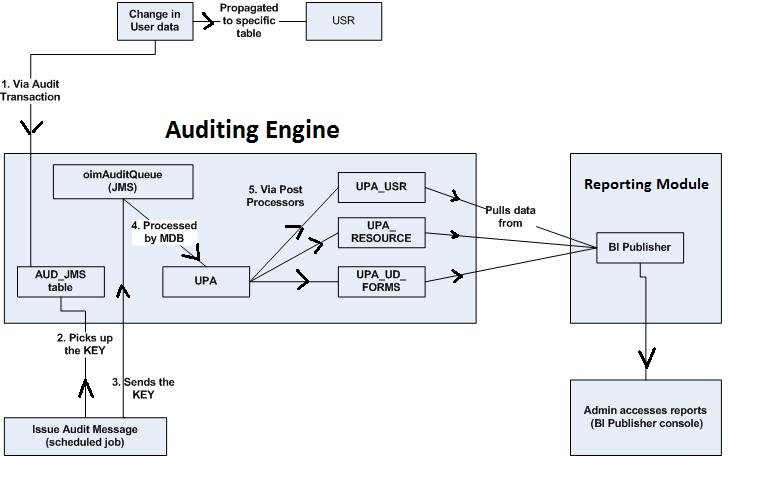A closer look at Oracle IDM Auditing
Reporting is a vital functionality in any product which deals with sensitive information. Same applies to Identity & Access Management tools. Oracle IDM’s Auditing module acts as a foundation for its OOTB Reporting capabilities. Let’s take a quick look at Auditing engine and how it facilitates the Reporting functionality within OIM.
The use case presented here is simple – change to a user record in OIM.
What are the sequence of events which get triggered from an Audit perspective?
This is best explained by a diagram. I came up with the figure below in an attempt to better articulate the process.
Although the diagram is self explanatory, a theoretical translation of the same is not going to harm us!
- The updated/created user record gets pushed into the USR table (stores the user information) – Its a normal process by which the information gets recorded in the OIM Database
- The information is further propagated by the OIM Auditing engine (as a part of core back end server logic) and it initiates a transaction
- The Audit Engine inserts a new entry in the AUD_JMS table as a part of the audit transaction completion. The AUD_JMS table is nothing but a staging table
- The Issue Audit Messages scheduled job picks up the Audit messages in the AUD_JMS table and submits the key to the oimAuditQueue JMS queue.
- The MDB corresponding to the queue initiates the Audit data processing – the data is seeded into the UPA table. This data is in the form of XML. These are snapshots of the user profile at the instant when the user record was actually modified/created. The UPA table also stores the delta (changes to the profile)
- Finally, the Post processors of the Audit engine pick up the XML snapshots from the central UPA table and store them in specific audit tables (in a de-normalized format) like UPA_USR, UPA_USR_FIELDS, UPA_RESOURCE, UPA_UD_FORMS etc
- These tables serve as the primary source of information for the Reporting module. If you have ever worked on the OIM Reporting module, I am sure you can relate to the Data Sources which you configure on your BI Publisher instance – these are for executing direct queries on the above mentioned Audit tables for its data.
That’s pretty much it ! This was not a coverage of the entire Audit module in OIM, but a preview of HOW the process is orchestrated on a high level.
Thanks for reading!
| Reference: | A closer look at Oracle IDM Auditing from our JCG partner Abhishek Gupta at the Object Oriented.. blog. |






